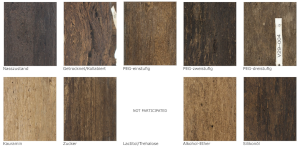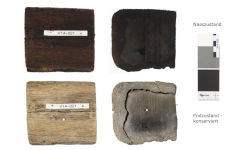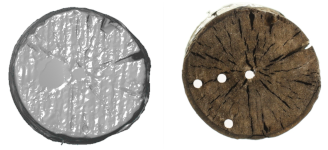Appearance/colour of preserved wood
The extent to which archaeological wood has retained its natural, original colour is difficult to assess, as it is no longer possible to trace the The extent to which archaeological wood has retained its natural colour is difficult to assess, as it is no longer possible to determine the colour-changing processes to which the wood was subjected both during use and during storage on the ground.
If one only looks at the cell wall-forming substances in the separated state, cellulose is rather greyish, white and lignin beige, brownish. If degradation processes cause a change in the composition, the colour impression also shifts with regard to the residual substances. If, for example, lignin is degraded and washed out, the wood appears more whitish-greyish. This "greying effect", which is usually caused by UV radiation, can be seen on untreated, freely weathered wood outdoors and driftwood. or also on wood affected by "white rot", a fungal attack that primarily decomposes the lignin. If, on the other hand, cellulose is decomposed, as in the case of "brown rot", for example, the wood takes on a brownish colour due to the remaining lignin.
Furthermore, the wood constituents stored in the cells are also significantly involved in the colouring, especially the colouring and tanning agents. The extent to which these have been washed out or chemically altered by long, wet storage in the ground and thus may have caused a change in colour, can no longer be traced. In addition, colouring foreign substances may have been washed into the wood from the surrounding environment of the deposit. A good example of such a colour-changing process in the soil can be seen in the so-called bog oak. Here, iron-containing water from the soil environment reacts with the tannins of the oak and colours the wood from very dark to black.
To objectively assess the colour of preserved and untreated archaeological wood, a test piece is actually required, dried without treatment with a stabilising agent, but without any loss of volume and the resulting "compression" of the wood mass. to serve as a reference. However, since this is not possible according to the current state of the art, we have decided to compare photos of the test specimens in the water-saturated, air-dried and preserved state in a colour comparison.
All photos were taken under the same conditions (same lighting, same camera - Canon EOS 450D, Canon EF 50mm, repro tripod). and with the same camera settings. In order to create the comparative "wood colour maps", representative representative sections of the individual images of the differently preserved wood samples were mounted next to each other for each test series.
For the photomontages of the individual wood samples in their preliminary and final state, the individual images were scaled beforehand using the scale/grey map. The different position of the objects in the pre- and then in the final state under the camera, the perspective distortion of the lens, as well as the altered height setting of the colour chart to the surface of the specimens and thus to the plane of focus are sources of error, despite the most careful alignment and scaling. and scaling are sources of error, which do not allow a dimensionally accurate and measurable reproduction of the changes from the preliminary to the final state in the photomontage.
Again, changes such as fine cracks can be seen in the photos, which are not detected by the strip-light scanner and are therefore not visible or only partially visible on the 3D model.




